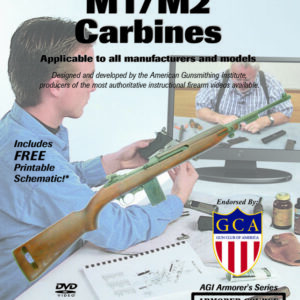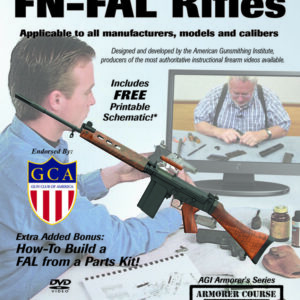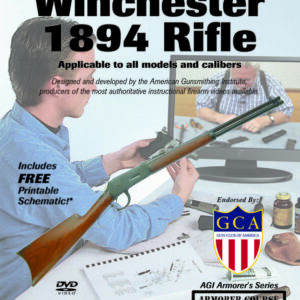Description
If you own or work on any of these guns, then you need the information contained on these videos! Only AGI’s Technical Manuals and Armorer’s Courses instruct you in every aspect of maintenance and repair of your firearms. Master gunsmith and senior instructor, Robert “Bob” Dunlap, teaches you complete disassembly and assembly (not just field stripping), parts identification, proper cleaning and lubrication. Bob also covers step-by-step instruction in design, function, and repair, including: locking systems, feeding systems, sears, triggers, and safeties. AGI Armorer’s Courses also include easy repairs for common problems and a free printable schematic.
The American Gunsmithing Institute’s instructors are all Certified Master Gunsmiths. At AGI, we adhere to the belief that you must fully understand how a firearm is designed to work before you can attempt to clean or repair it. AGI™s instructional videos provide you with this knowledge. Bob uses a custom cut-a way gun to enable you, in the usual AGI fashion, to see how the parts you cannot normally see operate inside the gun.
If you want the quick course on how to get the Walther PPK/S and FEG PA63 pistols apart, back together, and operating as intended, then this course is for you (if you want the long course, look into our basic 108 hour Professional Gunsmith Course.)
Among the items covered are:
History
- Bob gives us the Post-WWII history of Walther. From the German companies humble beginning, with some tooling and a few firearms diagrams, to the success of their product line of today, Walther continues to manufacture superb quality firearms
- Many guns were manufactured in France, even though their markings stated that they were made in Germany
- We are shown a rare model 1001 pistol, chambered for the .32 ACP cartridge, which has East German proof marks on it. The jump from the ramp to the barrel is designed correctly, unlike the version made in France. The ramp was not manufactured correctly again until Interarms began to manufacture the pistol under license from Walther in the United States many years later
- Many countries have copied all or part of the well thought out Walther design
- Special guest instructor, John Bush, fills us in on Walthers early history and shows us a variety of Pre-WWI/WWII models and designs
- We are shown an Olympic model pistol, built in 1932, which actually won 5 medals at the 1936 Olympics. The gun has a screwdriver built into the magazine (used for adjusting the front sight)
- After WWII, Walther licensed their pistol designs to Switzerland and France as a way to make money in West Germany, as they could not manufacture firearms themselves at that time
- John shows us many different Post-WWII models of Walther pistols and shares some interesting historical facts
- We are shown some special accessories for the Walther pistols (4mm center primed conversion cartridges and special barrel for shooting indoors, etc.)
Design & Function
- Through the use of a FEG PA63 cutaway pistol, we are shown the design and function of this unique pistol
- The differences and similarities between the FEG and the Walther are shown and explained throughout this section of the course
- The pistol is a straight blowback operated gun (no locking system or delay). This type of operation is thoroughly explained and demonstrated
- The extractors actual function and the ejection process in this type of firearm is explained
- The loaded chamber indicator is shown and demonstrated
- The function of the slide stop and magazine follower is demonstrated (last shot hold open explained)
- The firing sequence is explained and demonstrated through extreme close ups of the guns parts (both single and double action is explained)
- The various safeties functions are shown and demonstrated (firing pin/hammer block safety and manual safety)
- The decocking system is shown and demonstrated
- The functions of the hammer, hammer strut and main spring are shown and demonstrated (power adding and power robbing strokes are explained)
- The trigger bar and disconnector are shown and demonstrated
- The magazine and magazine catch are shown and explained
Disassembly
- Magazine disassembly is shown and demonstrated
- Slide disassembly is demonstrated (firing pin, extractor, plungers and spring, loaded chamber indicator). The unique movement of the trigger guard is shown
- Lower frame disassembly is shown and demonstrated (recoil spring, slide stop, hammer and main spring and plug, hammer strut, sear trip lever, hammer blocking safety, trigger pin, trigger guard, trigger, magazine catch, barrel)
- The feed ramp is shown and its function is explained. A diagram is shown to illustrate the proper dimensions of the ramps relation to the barrel is explained
- Barrel/feed ramp disassembly tips are given
- Sear removal and tips are discussed. Special disassembly plate is shown and its use is demonstrated. Sear engagement is explained
- The reassembly of the sear is shown and demonstrated for continuity
Cleaning & Lubrication
- AGI cleaning & lubrication methods shown, along with the reasons for their use
- After cleaning, dry with compressed air gun, hair dryer, or in the oven on Warm~185-200 degrees (metal parts ONLY)
- Lubing the Bob way, and what kind he likes
Reassembly
- Magazine reassembly and tips are given and demonstrated
- The correct order of parts for reassembly is given so that you do not have any parts left over
- Slide reassembly is shown and demonstrated.
- Lower frame reassembly is shown and demonstrated. Tips for easier reassembly are given and demonstrated
- Checking the safety timing is explained and cautions are given
- P38 safeties are shown and discussed
- PA63 safety and its function is shown and explained
- P4 safety features are shown and explained
If you noticed how often the terms “explanation” and “demonstration” are used, you may be getting some idea of why this course is necessary for any Walther PPK/S and FEG PA63 owner, or someone who intends to be.




